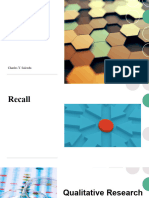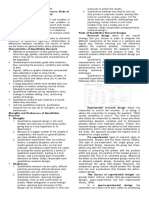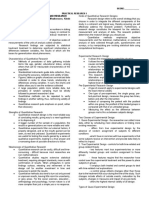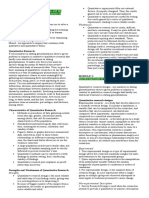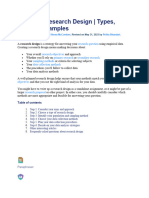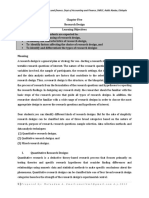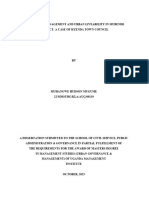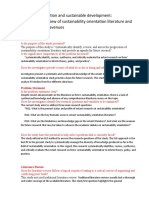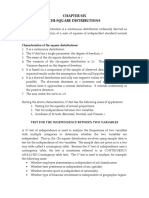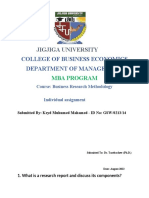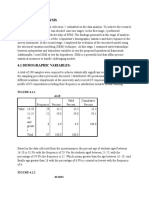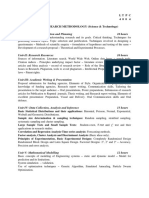0 ratings0% found this document useful (0 votes)
13 viewsQunatitative Research
Qunatitative Research
Uploaded by
Joshua JavierQuantitative research uses numerical data and statistical analysis to generalize findings about a problem. It relies on objective measurement and standardized instruments. Common quantitative designs include experimental designs which manipulate variables, and non-experimental designs like surveys, correlational studies, ex-post facto studies, comparative studies, and evaluative studies which observe phenomena as they naturally occur. Strengths include reliability and validity, but weaknesses include high costs and difficulties with statistical analysis and ambiguity.
Copyright:
© All Rights Reserved
Available Formats
Download as PDF, TXT or read online from Scribd
Qunatitative Research
Qunatitative Research
Uploaded by
Joshua Javier0 ratings0% found this document useful (0 votes)
13 views30 pagesQuantitative research uses numerical data and statistical analysis to generalize findings about a problem. It relies on objective measurement and standardized instruments. Common quantitative designs include experimental designs which manipulate variables, and non-experimental designs like surveys, correlational studies, ex-post facto studies, comparative studies, and evaluative studies which observe phenomena as they naturally occur. Strengths include reliability and validity, but weaknesses include high costs and difficulties with statistical analysis and ambiguity.
Original Title
Qunatitative-Research
Copyright
© © All Rights Reserved
Available Formats
PDF, TXT or read online from Scribd
Share this document
Did you find this document useful?
Is this content inappropriate?
Quantitative research uses numerical data and statistical analysis to generalize findings about a problem. It relies on objective measurement and standardized instruments. Common quantitative designs include experimental designs which manipulate variables, and non-experimental designs like surveys, correlational studies, ex-post facto studies, comparative studies, and evaluative studies which observe phenomena as they naturally occur. Strengths include reliability and validity, but weaknesses include high costs and difficulties with statistical analysis and ambiguity.
Copyright:
© All Rights Reserved
Available Formats
Download as PDF, TXT or read online from Scribd
Download as pdf or txt
0 ratings0% found this document useful (0 votes)
13 views30 pagesQunatitative Research
Qunatitative Research
Uploaded by
Joshua JavierQuantitative research uses numerical data and statistical analysis to generalize findings about a problem. It relies on objective measurement and standardized instruments. Common quantitative designs include experimental designs which manipulate variables, and non-experimental designs like surveys, correlational studies, ex-post facto studies, comparative studies, and evaluative studies which observe phenomena as they naturally occur. Strengths include reliability and validity, but weaknesses include high costs and difficulties with statistical analysis and ambiguity.
Copyright:
© All Rights Reserved
Available Formats
Download as PDF, TXT or read online from Scribd
Download as pdf or txt
You are on page 1of 30
Characteristics, Strengths,
Weaknesses, Kinds of Quantitative
Research
Prepared by Sir JM Realco
INTRODUCTION
Quantitative Research Designs use numbers in
stating generalizations about given problem or
inquiry in contrast to qualitative research that
hardly uses statistical treatment in stating
generalizations.
INTRODUCTION
The numbers are the results of objective scales of
measurements of the units of analysis called
variables.
Research findings are subjected to statistical
treatment to determine significant relationships or
differences between variables, the results of which
are the bases for generalization about phenomena.
Characteristics of Quantitative
Research
• Methods or procedures of data gathering
include items like age, gender, educational
status, among others, that call for measurable
characteristics of population
Characteristics of Quantitative
Research
• Standardized instruments guide data
collection, thus, ensuring the accuracy,
reliability and validity of data.
Characteristics of Quantitative
Research
• Figure, tables or graphs showcase summarized
data collected in order to show trends,
relationships or differences among variables.
• In sum, the charts and tables allow you to see
the evidence collected.
Characteristics of Quantitative
Research
• A large population yields more reliable data,
but principles of random sampling must be
strictly followed to prevent researcher’s bias.
Characteristics of Quantitative
Research
• Quantitative methods can be repeated to
verify findings in another setting, thus,
reinforcing validity of findings.
• Quantitative methods research puts emphasis
on proof, rather than discovery.
Strength and Weaknesses of
Quantitative Research
Strengths
It is the most reliable and valid way of
concluding results, giving way to a new
hypothesis or to disproving it.
Strengths
Because of a bigger number of the sample of
a population, the results or generalizations are
more reliable and valid.
Strengths
Filter out external factors, if properly
designed, and so the results gained can be seen,
as real and unbiased. Quantitative experiments
are useful for testing the results gained by a
series of qualitative experiments, leading to a
final answer, and a narrowing down of possible
directions to follow.
Weakness
Quantitative research can be costly, difficult
and time-consuming – difficult because most
researches are non-mathematicians.
Weakness
Quantitative studies require extensive
statistical treatment, requiring stringent
standards, more so with confirmation of results.
When ambiguities in some findings surface,
retesting and refinement of the design call for
another investment in time and resources to
polish the results.
Weakness
Quantitative methods also tend to turn out
only proved or unproven results, leaving little
room for uncertainty, or grey areas. For the
social sciences, education, anthropology and
psychology, human nature is a lot more complex
than just a simple yes or no response.
Kinds of Quantitative Research Design
Research design refers to the overall strategy
that chooses in order to integrate the different
components of the study in a coherent and logical
way, thereby ensuring you will effectively address
eh research problem. Furthermore, a research
design constitutes the blueprint for the selection,
measurement and analysis of data. The research
problem determines the research design you should
be use.
Kinds of Quantitative Research Design
Quantitative methods emphasize objective
measurements and the statistical, mathematical,
or numerical analysis of data collected through
polls, questionnaires, and surveys, or by
manipulating pre-existing statistical data using
computational techniques.
Kinds of Quantitative Research Design
Quantitative research designs are generally
classified experimental or non-experimental as
the following matrix shows:
Quantitative Design Qualitative Design
Experimental Non-Experimental
True Quasi- Pre-
Descriptive
Experimental Experimental Experimental
1. Pre-Test 1. Non- 1. One shot 1. Survey 1. Focus Group
Design equivalent case study 2. Correlational Discussion
2. Post-Test control 2. One group 3. Ex-Post Facto 2. Grounded Theory
Design group pre-test Studies 3. Phenomenology
3. Post-Test design post-test 4. Comparative 4. Discourse
only/contr 2. Time series design 5. Evaluative Analysis
ol Group Design 6. Methodological 5. Participant
Design Observation
Experimental Research
Allows researcher to control the situation. In so
doing, it allows the researchers to answer the
question, “What causes something to occur?”
this kind of research also allows researcher to
identify cause and effect relationship between
variables
Non-Experimental Research
In this kind of research design, the researcher
observes the phenomena as they occur naturally
and no external variables are introduced. In this
design, the variables are not deliberately
manipulated nor setting controlled. Researchers
collect data without making changes or
introducing treatments.
Non-Experimental Research
Its main purpose is to observe, describe and
document aspects of a situation as it naturally
occurs and sometimes to serve as a starting
point for hypothesis generation or theory
development.
Types of Descriptive Design
Survey – it is used when researcher intends to
provide a quantitative or numeric description of
trends, attitudes or opinions of a population by
studying a sample of that population. Example,
universities regularly float surveys to determine
customer satisfaction, that is, students’ attitudes
toward or opinions regarding students services like
canteen, clinic, security, the guidance and
counseling and a like.
Types of Descriptive Design
Correlational – It has three types:
1. Bivariate – obtain scores from two variables
for each subject, then use them to calculate a
correlation coefficient. The term bivariate
implies that the two variables are correlated
(variables are selected because they are
believed to be related)
Types of Descriptive Design
Correlational – It has three types:
2. Prediction studies – use correlational co-
efficient to show how one variable predicts one
another.
Types of Descriptive Design
Correlational – It has three types:
3. Multiple regression Prediction -
Types of Descriptive Design
Ex-Post Facto – A non-experimental designs that are
used to investigate causal relationships. They
examine whether one or more pre-existing could
possibly have caused subsequent differences in
group subjects. Researcher attempts to discover
whether differences between groups have results in
an observed difference in the independent
variables.
Types of Descriptive Design
Comparative – involves comparing and contrasting
two or more samples of study subjects on one or
more variables, often at a single point of time.
Specifically, this design is used to compare two
distinct groups on the basis of selected attributes
such as knowledge level, perceptions, and attitudes,
physical or psychological symptoms.
Types of Descriptive Design
Evaluative – seeks to assess or judge in some
way providing information about something
other than might be gleaned in mere
observation and investigation of relationships.
Types of Descriptive Design
Methodological - in this approach, the
implementation of a variety of methodologies
forms a critical part of achieving the goal of
developing a scale-matched approach, where
data from different disciplines can be integrated
You might also like
- Research Approaches and DesignsDocument3 pagesResearch Approaches and DesignsAnnapurna Dangeti90% (10)
- Practical Research 2: Quarter 4 - Module 4Document20 pagesPractical Research 2: Quarter 4 - Module 4dv vargas0% (1)
- Research Design Useful in Daily LifeDocument11 pagesResearch Design Useful in Daily LifeAlthea Faye Abarracoso Ramos60% (10)
- Inbound 4589109284561518719Document38 pagesInbound 4589109284561518719Wayne AgudaNo ratings yet
- Lesson 1Document2 pagesLesson 1Marky Zhaijan RamosNo ratings yet
- Chapter 1 Lesson 1 Characteristics StrenDocument2 pagesChapter 1 Lesson 1 Characteristics StrenDonna CasillaNo ratings yet
- Conceptualising A Research DesignDocument42 pagesConceptualising A Research DesignKareem MostafaNo ratings yet
- Chapter 1 Lesson 1 Characteristics StrenDocument4 pagesChapter 1 Lesson 1 Characteristics StrenDanielaNo ratings yet
- Practical Research 2 Lesson 1Document3 pagesPractical Research 2 Lesson 1Pepito ManlolokoNo ratings yet
- Lesson 1 2 Characteristics of Quantitative Research and Importance Across FieldsDocument13 pagesLesson 1 2 Characteristics of Quantitative Research and Importance Across FieldsBAUTISTA, CASHIESCA M.No ratings yet
- Lesson 1 Definition of Quantitative Research - pdf2Document8 pagesLesson 1 Definition of Quantitative Research - pdf2Funny JuanNo ratings yet
- Describing Characteristics, Strengths, Weaknesses and Kinds of Quantitative ResearchDocument52 pagesDescribing Characteristics, Strengths, Weaknesses and Kinds of Quantitative ResearchRicardo MawasNo ratings yet
- Research-L11 Quantitative Research DesignDocument21 pagesResearch-L11 Quantitative Research DesignVevienne Canta100% (1)
- Welcome, Grade 12 ABM Students!Document37 pagesWelcome, Grade 12 ABM Students!PSHNo ratings yet
- Research Final Exam ReviewerDocument7 pagesResearch Final Exam ReviewerRhanessa Banacia NordanNo ratings yet
- Researc DesinDocument15 pagesResearc DesinValarmathiNo ratings yet
- Collecting DataDocument21 pagesCollecting DataGlo Anne Ordoño SabadoNo ratings yet
- Session 1Document22 pagesSession 1Alpha Parman BagorioNo ratings yet
- Quantitative Research DesignsDocument3 pagesQuantitative Research Designsvox shawtyNo ratings yet
- Characteristics Strengths Weaknesses Kinds ofDocument52 pagesCharacteristics Strengths Weaknesses Kinds ofKim Ann OpenaNo ratings yet
- Research Design - PresentationDocument11 pagesResearch Design - PresentationdumisaniNo ratings yet
- Practical Research 2 - Chap.3Document28 pagesPractical Research 2 - Chap.3wendell john medianaNo ratings yet
- Research Design - KomalDocument13 pagesResearch Design - KomalNAKSH 5ANo ratings yet
- Quantitative Design Qualitative Design Experimental Non-ExperimentalDocument53 pagesQuantitative Design Qualitative Design Experimental Non-ExperimentalCristine Galanga FajanilanNo ratings yet
- Methods of Collecting DataDocument26 pagesMethods of Collecting DataLolol LololNo ratings yet
- Lesson 1: The Characteristics, Strengths, Weaknesses, and Kinds of Quantitative ResearchDocument8 pagesLesson 1: The Characteristics, Strengths, Weaknesses, and Kinds of Quantitative ResearchAlma Cecilia Quiao100% (2)
- Mims PR2 LC1 Quantitative ResearchDocument11 pagesMims PR2 LC1 Quantitative ResearchJester Guballa de LeonNo ratings yet
- 5 Research DesignDocument82 pages5 Research Designmayanksharma248No ratings yet
- Kinds of Quantitative Research DesignsDocument26 pagesKinds of Quantitative Research DesignsJohn JoshNo ratings yet
- Practical Research 2: Quarter 1, Week 1Document37 pagesPractical Research 2: Quarter 1, Week 1JOHN KENNETH MANOZONNo ratings yet
- Prac2 q4 Mod4.No Answer KeyDocument47 pagesPrac2 q4 Mod4.No Answer KeyjungcolemerjerihNo ratings yet
- What Is A Research DesignDocument13 pagesWhat Is A Research DesignLhykz DG GaringaraoNo ratings yet
- Kinds of Quantitative ResearchDocument3 pagesKinds of Quantitative ResearchAugusto Dolores RholuNo ratings yet
- Research in Daily Life II Module 1Document7 pagesResearch in Daily Life II Module 1RyzaNo ratings yet
- Research DesignDocument14 pagesResearch Designbaccayjomari08No ratings yet
- Research Design - What It Is Elements Types - QuestionProDocument5 pagesResearch Design - What It Is Elements Types - QuestionProZa InNo ratings yet
- Handouts in Research 2Document5 pagesHandouts in Research 2nona yamutNo ratings yet
- Research Design - by Faisal HakimzadDocument12 pagesResearch Design - by Faisal HakimzadHakimzad9001 Faisal9001No ratings yet
- Lesson 1 Characteristics Strengths Weaknesses Kinds of Quantitaitve Reesearch 1 PDFDocument46 pagesLesson 1 Characteristics Strengths Weaknesses Kinds of Quantitaitve Reesearch 1 PDFKiri SorianoNo ratings yet
- Research DesignDocument4 pagesResearch DesignAshley LigutanNo ratings yet
- 1 - Quantitative Research DesignsDocument2 pages1 - Quantitative Research DesignsMeryl LabatanaNo ratings yet
- Understanding Data and Ways To Systematically Collect DataDocument39 pagesUnderstanding Data and Ways To Systematically Collect DataTammyQuiwaHermosa100% (1)
- Quantitative Research Design E-LPDocument7 pagesQuantitative Research Design E-LPma.anne rodiNo ratings yet
- Pr2 Week 1Document17 pagesPr2 Week 1Julie CabusaoNo ratings yet
- Characteristics of Quantitative ResearchDocument31 pagesCharacteristics of Quantitative ResearchDayhen Afable BianesNo ratings yet
- Unit Iv. Lesson I Methodology: Cagayan State University-Lal - Lo CampusDocument8 pagesUnit Iv. Lesson I Methodology: Cagayan State University-Lal - Lo CampusKrhyz Axl Ramos-Buraga ValenzuelaNo ratings yet
- Research Design Definition Characteristics and TypesDocument3 pagesResearch Design Definition Characteristics and TypesManjit KaurNo ratings yet
- Research Design What Is A Research Design?Document7 pagesResearch Design What Is A Research Design?ChigemezuNo ratings yet
- Research Design DefinitionDocument7 pagesResearch Design Definitionstudent0990No ratings yet
- Lecture No. 2.1 Quantitative Research DesignDocument11 pagesLecture No. 2.1 Quantitative Research DesignSilang MatthewNo ratings yet
- Research Design Elements and TypesDocument9 pagesResearch Design Elements and TypesSMiley XeroxNo ratings yet
- Prac Res 2 Ls 1 PDFDocument10 pagesPrac Res 2 Ls 1 PDFPARE HANNE VILLARINNo ratings yet
- Lesson 1 PR2Document67 pagesLesson 1 PR2Louis Sebastian LunaNo ratings yet
- Chapter Five Research DesignDocument9 pagesChapter Five Research DesignWondwosen TilahunNo ratings yet
- Practical Research 2: Quantitative Research Glicerio V. Valenciano, RN, ManDocument12 pagesPractical Research 2: Quantitative Research Glicerio V. Valenciano, RN, ManCarlos NiñoNo ratings yet
- Research IIDocument42 pagesResearch IIChristine Jean CeredonNo ratings yet
- pr2 Q2 WEEK 1 LAS 1 & 2Document8 pagespr2 Q2 WEEK 1 LAS 1 & 2ENJELY SIMBANANNo ratings yet
- Division Enhancement On Senior High School Inquiries Investigation and ImmersionDocument63 pagesDivision Enhancement On Senior High School Inquiries Investigation and ImmersionAshley Jade Hanna FloresNo ratings yet
- Organizing A Research ReportDocument51 pagesOrganizing A Research ReportARLYN BERNALDEZNo ratings yet
- Practice Test Test 4 - Bus2023 - Spring09 - SolutionsDocument10 pagesPractice Test Test 4 - Bus2023 - Spring09 - SolutionsjonNo ratings yet
- AE 9-STATISTICAL TOOLS FinalsDocument2 pagesAE 9-STATISTICAL TOOLS FinalsJohn Mark PalapuzNo ratings yet
- Hypothesis Testing FinalDocument14 pagesHypothesis Testing FinalDhruvin SakariyaNo ratings yet
- Pragmatism and Logical PositivismDocument3 pagesPragmatism and Logical PositivismAnum MubasharNo ratings yet
- Practical Research 1 Final ExamDocument9 pagesPractical Research 1 Final ExamRolly DayritNo ratings yet
- Hudson DissertationDocument90 pagesHudson DissertationWomayi SamsonNo ratings yet
- Business Orientation and Sustainable Development: A Systematic Review of Sustainability Orientation Literature and Future Research AvenuesDocument4 pagesBusiness Orientation and Sustainable Development: A Systematic Review of Sustainability Orientation Literature and Future Research AvenuesNumera SaleemNo ratings yet
- Anish Bhandari.22015997.FE5056, Problem Solving Methods and AnalysisDocument20 pagesAnish Bhandari.22015997.FE5056, Problem Solving Methods and AnalysisAnish bhandariNo ratings yet
- Chapter Six Chi-Square DistributionsDocument27 pagesChapter Six Chi-Square DistributionsSolomonNo ratings yet
- CHAPTER-1-PR2 Quantitative ResearchDocument3 pagesCHAPTER-1-PR2 Quantitative ResearchAnonymousNo ratings yet
- EBSIPE+16 18+handbookDocument35 pagesEBSIPE+16 18+handbookANo ratings yet
- Individual Assignment - BRM - Keyd MDocument15 pagesIndividual Assignment - BRM - Keyd MKeyd MuhumedNo ratings yet
- Apresiasi Sastra AnakDocument14 pagesApresiasi Sastra AnakFebryana AlwiNo ratings yet
- Chapter # 4 Analysis: DegreeDocument8 pagesChapter # 4 Analysis: DegreeDure KashafNo ratings yet
- Media Research Notes August 2013Document8 pagesMedia Research Notes August 2013Gautam GopalNo ratings yet
- Dang Ngoc Thien-44.01.701.048 1Document5 pagesDang Ngoc Thien-44.01.701.048 1Hoang vyNo ratings yet
- Reading List MSC Tourism Management and Marketing 05Document4 pagesReading List MSC Tourism Management and Marketing 05dHaNiaaaaaNo ratings yet
- Rme001 Syllabus STDocument2 pagesRme001 Syllabus STsanjay MariyanNo ratings yet
- Successful ProposalDocument2 pagesSuccessful Proposalumaid70No ratings yet
- An Evaluation of Reading Skills and StrategiesDocument9 pagesAn Evaluation of Reading Skills and StrategiesAldrin MendezNo ratings yet
- Business Research Prelim Quiz 1 - Attempt ReviewDocument4 pagesBusiness Research Prelim Quiz 1 - Attempt ReviewJasmin GamboaNo ratings yet
- RESEARCH 1 MELC 3rd 4th Quarter ASSIGNED SCHOOLSDocument5 pagesRESEARCH 1 MELC 3rd 4th Quarter ASSIGNED SCHOOLSJovelyn Amasa CatongNo ratings yet
- Sbe10 01Document7 pagesSbe10 01Kashif javedNo ratings yet
- Work Sheet For RRLDocument10 pagesWork Sheet For RRLIsaiah GonzalesNo ratings yet
- Lessaon Plan in Res. 7Document6 pagesLessaon Plan in Res. 7reyjohngallentesNo ratings yet
- Statistics For Managers Using Microsoft Excel: 3 EditionDocument28 pagesStatistics For Managers Using Microsoft Excel: 3 EditionBagian Kebijakan dan Program BIROREN KEMENTANNo ratings yet
- Engineering Statistic FormulaeDocument5 pagesEngineering Statistic FormulaeYiXuanYeoNo ratings yet
- LP2 - Unit-2 - GE10-Methods of ResearchDocument15 pagesLP2 - Unit-2 - GE10-Methods of ResearchCza Mae ArsenalNo ratings yet
- St. Lawrence High School: First Term Worksheet No. - 16 Class: 11Document2 pagesSt. Lawrence High School: First Term Worksheet No. - 16 Class: 11asimNo ratings yet




